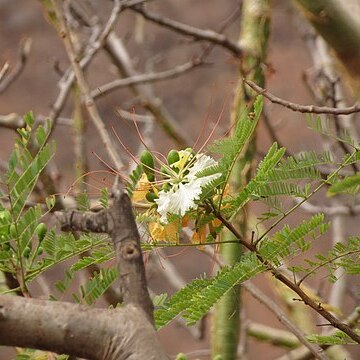A deciduous tree. It grows 4-15 m high. It has a spreading arching habit. The bark is shiny and smooth and can be flaky. The young leaves are soft grey-green. The leaves are twice divided and feather like. There are 2-12 pairs of leaflets. They are oval and less than 1 cm long. The flowers are 20 cm across. They are white to pale orange. They have 4 wavy white petals and one smaller white petal. The stamens are long and orange-brown. Only one flower in a group opens at a time. The fruit are thin, red-brown pods. They taper at both ends. The pods are 20 cm long and remain on the tree.
Leaves: petiole and rachis together (4)8–20 cm long; pinnae 2–12 pairs; pinna rachis (0.5)1–9 cm long; leaflets (8)11–25 pairs, 4–17 × (1)1.5–4(4) mm, oblong, ± rounded at the apex, asymmetrical at the base, finely appressed-pubescent on both surfaces, sometimes glabrescent above; stipules subulate, up to 3 mm long, caducous.
Racemes short, the axis up to 5 cm long and ± densely appressed-or spreading-pubescent, each with about 5–20 flowers; bracts up to 3.5 × 2.5 mm, but usually falling at a very early stage, ovate, densely pubescent; pedicels 1.5–3.5(5) cm long.
Hypanthium including a narrow basal part 1–4 mm long abruptly expanded above into a conspicuous campanulate part 3–7(8) mm long, the whole on the outside finely pubescent with appressed grey hairs to densely brown-tomentose.
Petals 1.6–3.2(3.8) cm long, the upper one smaller than the others and yellow to orange, the others white but fading to yellow or orange, all ± lacerate and crisped at the upper margin.
Sepals 1.2–3.3(4) cm long, lanceolate to oblong, tapering above to an ± acute apex, similar to the hypanthium in pubescence.
Young stems thinly appressed-pubescent to densely spreading-pubescent, later glabrescent.
Tree 2.5–15 m high with rounded spreading crown and rather smooth, buff or grey bark.
Stamen filaments 3–11(14) cm long, bright red, much exceeding the petals.
Pods 13–26 × 2.1–3.7 cm; seeds 8–19, c.15 × 8 × 3 mm, compressed.
Ovary shortly stipitate, densely pubescent, often ± sericeous.


